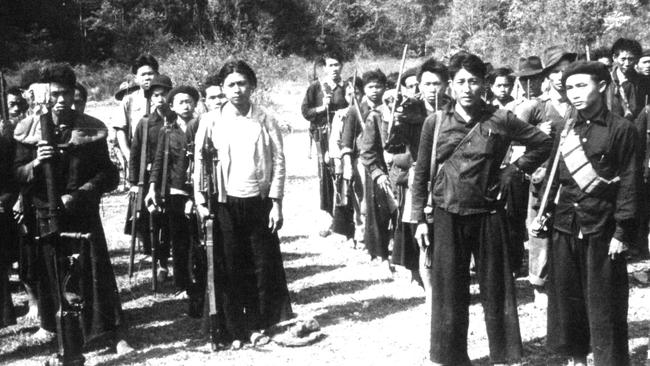CIA’s role in Laos conflict explored in A Great Place to Have a War
The Vietnam War has long overshadowed the conflict in Laos but a new book seeks to redress the balance.

There are whole libraries of books on the Vietnam War but nothing like as much has been written about the conflict in Laos that took place during the same period. This work by Joshua Kurlantzick, who is based at the Council on Foreign Relations in New York, looks in detail at this comparatively unknown war.
Its origins lay in the immediate aftermath of World War II when the Japanese were forced to surrender the French colony of Laos to its former masters. But France’s empire in Indochina was finished and Laos became an independent state in 1954, together with North and South Vietnam.
For the remainder of the 1950s, however, the new government waged a continuing battle with communist Pathet Lao guerillas and the North Vietnamese troops who supported the insurgents. On the government side, the official Laotian army was supported by the Hmong tribe in the centre and north of the country, along with a number of Thai mercenaries. There was also some assistance from the CIA.
The significance accorded to the conflict in Laos by the Eisenhower administration is illustrated by the fact that, when power changed hands in 1961, Dwight Eisenhower described it to John F. Kennedy as the most important issue facing the new president. This concern was reflected in the CIA’s decision that year to begin providing large-scale funds and supplies to a Hmong army under its commander Vang Pao — a force that reached 20,000 men by 1963.
As noted in A Great Place to Have a War: America in Laos and the Birth of a Military CIA, Kennedy had his doubts about this strategy, writing on a memo sent to him in 1961 that Laos was “a most inhospitable area in which to wage a campaign” and “the chances of eradicating the Communist position … are practically nil”.
In July 1964 a decision was taken by the Johnson administration in Washington to bomb the positions of Pathet Lao and North Vietnamese troops as well as the Ho Chi Minh Trail that ran through Laos and allowed North Vietnam to supply its forces in South Vietnam. At about the same time one of this book’s central characters, William Sullivan, arrived in the Laotian capital Vientiane as US ambassador.
Although the CIA continued to supervise the war on a day-to-day basis, Sullivan took a keen interest in every aspect of its operations and no major decisions were made without his agreement. One of those decisions in 1966 was to significantly widen the conflict by initiating conventional ground battles with the enemy, chiefly through use of the Hmong forces.
As Kurlantzick’s book points out, the goal of this exercise was to divert the North Vietnamese contingent from South Vietnam and then sap its strength. There was no particular interest in the present or future condition of Laos — quite similar to the indifference of the Americans, and the Australian government, to South Vietnam except as an obstacle to communist expansion in Southeast Asia.
By 1969 the US bombing sorties had gone from a starting point of 20 a day to 300 a day, although knowledge of the very existence of the war was still confined to a small group in what was now the Nixon administration in Washington. In March 1970, Richard Nixon made the first public disclosure of the conflict — but not the level to which it had reached. This statement had little public impact, largely because, unlike in Vietnam, there were no significant American ground forces in Laos, and so no American casualties.
The book details the results of the bombing where it was most heavily concentrated — in the middle of the country on the Plain of Jars, where 150,000 people had lived before 1960 and 9000 remained in 1970.
But the Americans were about to lose interest in Laos. In January 1973 the so-called Paris Peace Accords were signed between North and South Vietnam. Secretary of state Henry Kissinger was the chief US negotiator, although much of the spadework was done by the ubiquitous Sullivan, now back in Washington.
Two years later, South Vietnam was gone. As for Laos, Kissinger forced its government to form a coalition with the Pathet Lao. Events then took the same course as in Vietnam. In August 1975 Pathet Lao troops entered Vientiane, and in December took over the government.
Their enemies were sent to labour camps, especially the Hmong, although 100,000 of them fled to Thailand, where they survived in refugee camps until some were able to get to the US. Vang Po was taken to the US and, somewhat incongruously, installed on a ranch in Montana.
The net result of all this was that by the end of 1975 about 200,000 Laotians had been killed, including 30,000 Hmong — a tenth of the total population.
Twice as many had been wounded by ground fighting and bombing, and about a quarter of the population had been displaced from their towns and villages. One-third of the bombs dropped remained undetonated and continued to kill those who stumbled on them for decades afterwards.
This is an important book that recounts with great clarity — although, disappointingly, without photos or maps — one of the least known conflicts of the postwar years.
It is also another indictment of the foreign policy and military advisers in the Kennedy and Johnson administrations — “the best and the brightest”, as the ironic title of David Halberstam’s 1972 book has it.
A Great Place to Have a War: America in Laos and the Birth of a Military CIA
By Joshua Kurlantzick
Simon & Schuster, 325pp, $79.99 (HB), $14.99 (eBook)
Michael Sexton’s latest book is On the Edges of History: A Memoir of Law, Books and Politics.


